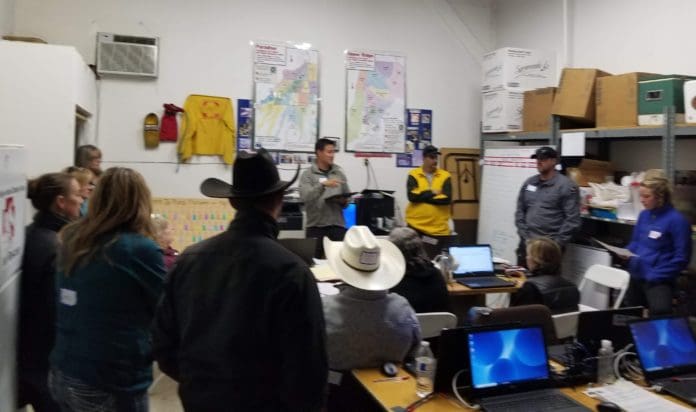I stopped that account on the night before my first day volunteering at one of the two sites established for animals who were being evacuated from the fire zone. I had actually been at one of the sites all day, but it was too fresh; I couldn’t have written about that day on that night if I had to.
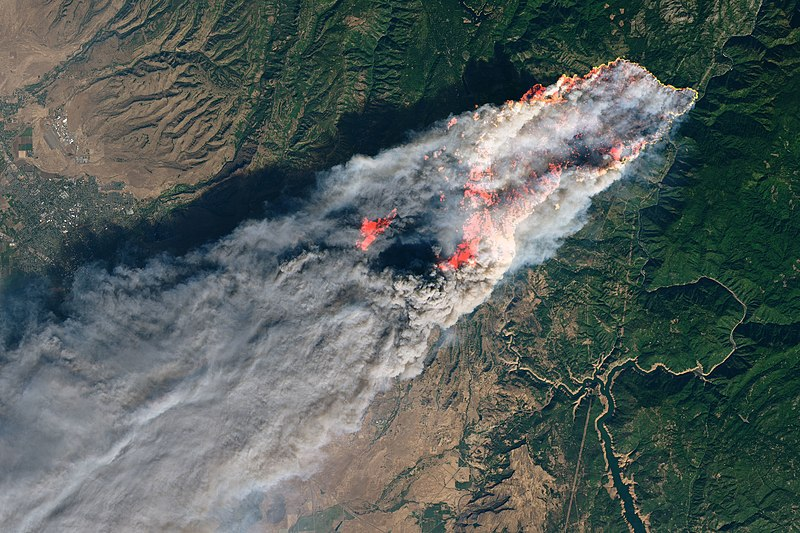
There are animals at these sites for two reasons: either they were brought to the emergency shelter by owners who fled the fire and who have no place to stay where they can have their animals with them, or they were rescued by law enforcement officers and volunteers who are allowed behind the mandatory evacuation lines and brought to the shelter.
Animals who were burned and in need of medical care are being taken to veterinary hospitals. I haven’t seen any of those animals in person.
One of the two emergency shelters was established at the old airport in Chico, about 30 miles north and west of me, and one was established in an old county hospital building here in Oroville, the town where I live. The fire zone is triangulated right between these two sites.
There is a local organization that was activated within minutes of the first sign of smoke from Camp Fire: the North Valley Animal Disaster Group (NVADG, which is pronounced locally as “nav-dag”). It’s an all-volunteer group that provides ongoing training for people who are interested in helping with all types and sizes of animal rescues in this part of the state, from overturned horse or cattle trailers to all-too-common wildfires.
NVADG volunteers immediately started working with law enforcement to rescue animals in the fire zone and were setting up the emergency shelters within hours. The first started early in the morning on November 8, and the shelters filled very quickly with animals. The call went out for more cages, more cages, and more cages.
Within a day, there were more than 1,000 dogs, cats, chickens, ducks, pet birds, snakes, and more at these shelters. Large animals including horses, cows, goats, sheep, and pigs were taken to other shelters. Care and feeding of the animals – not an insignificant task that involved taking dogs out of their cages to potty, and cleaning cat boxes – fell to NVADG volunteers. (As of today, more than 2,000 animals who have been rescued or evacuated from the fire are currently being housed and cared for in NVADG shelters and in veterinary hospitals.)
Ordinarily, NVADG allows only people who have attended one of its training sessions to participate in one of its emergency response events. But within a week, its volunteer network was very strained. Caged animals need lots of care, and there were LOTS of them, and more arriving from the fire zone every day.
My friend Sarah Richardson was contacted by someone in NVADG and asked for help. Because Sarah has been training dogs in Chico for more than a decade, and runs a boarding and daycare facility, she has an extensive network of clients and employees that she can ask to help in an emergency. In fact, many of them did so when Sarah took in a bunch of dogs from the evacuation of my local shelter during the Oroville Dam crisis two years ago! So that’s how I, Sarah, and a half dozen or so of her employees and clients ended up reporting for volunteer service at NVADG’s Oroville emergency shelter site, at 7 am on day seven of the fire.
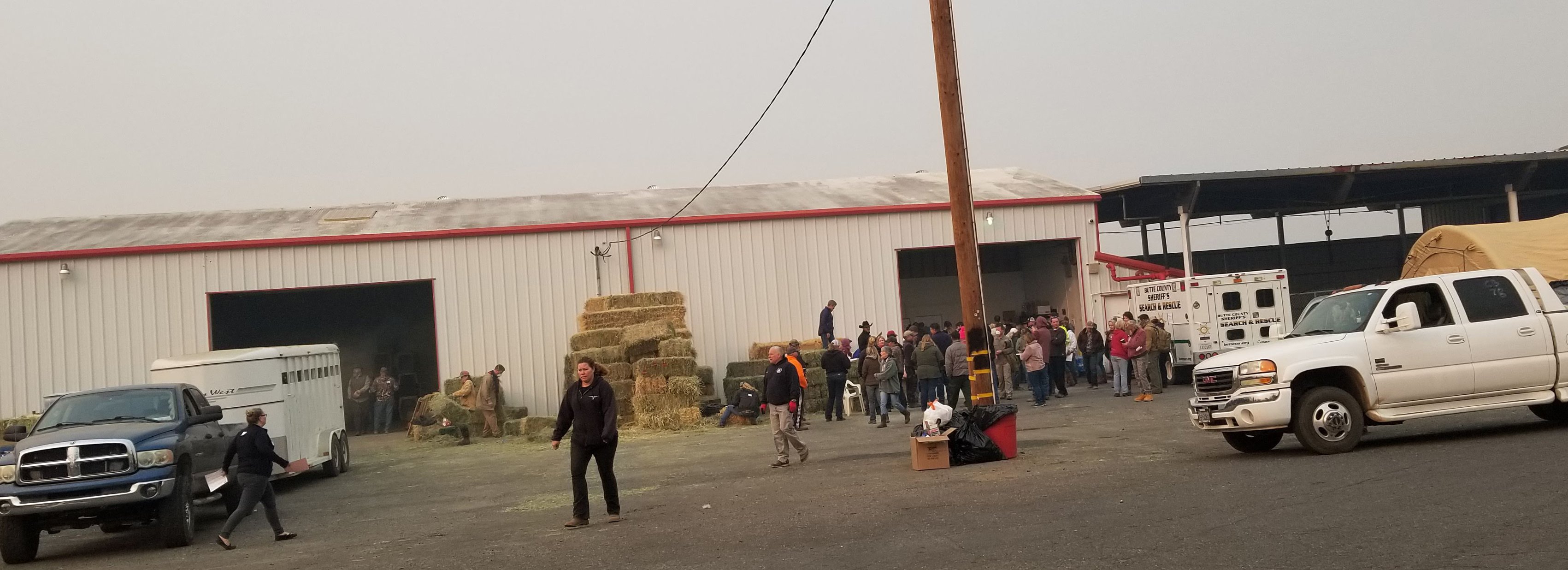
Dog Disaster Relief
I’m glad someone called Sarah, because when we got there, only one other volunteer was on the grounds, although more kept trickling in as we got to work. We were briefed on what was where and what to do – and I mean, briefed. Leashes are here, poop bags are there, go that way… Two or three of you take dogs out to walk and one person will clean its cage while the walkers are outside. Dump the water bowl, wipe it out with paper towels. Check the bedding (if any). If it’s soiled, take it out, and put it in that barrel. Fresh bedding is over there. Put some food in a paper bowl. That’s that. And write on the chart whether the dog had finished its food from the previous feeding. The walkers will indicate whether the dog pooped or peed, and note whether each dog seems to have any health issues that the vets should look at.
Problems cropped up and we solved them as we went. We ran out of large plastic garbage bags; someone found more. The poop barrels filled; someone stepped up and found a cart to haul the large garbage bags full of poop bags to a dumpster. This dog was going berserk and kept getting trapped halfway in and halfway out of its cage, bending the bars with superdog strength; we arranged for that one to be transported to the local shelter, which has a far more secure facility. That dog has a terrible case of fleas and tapeworms in her poop; she got put on the vets’ list for treatment for both issues. And on and on.
By about 2 pm, about 20 volunteers were present, and all the dogs had been outside at least once, and all the cat boxes and cat cages had been cleaned – and it was time to start over at the beginning. I could easily see why the NVADG volunteers were exhausted. And this was the smaller of the two shelters being operated by NVADG!
In addition, the work was not just physically tiring – it was emotionally challenging. It was cold outside, with the sun being completely blotted out by all the smoke in the sky. Many of us were wearing masks in an effort to filter the air, but we had headaches and raw throats and runny noses anyway. Most of the dogs were frantic to get out of their cages (wire crates) and get out of the rooms in the building that NVADG has been allowed to use. All the spaces were quite small and have poor ventilation; the room with the best ventilation and most open space was up a flight of narrow stairs! A bit of a hazard when being pulled downstairs by large, stressed dogs.
SEE ALSO: Smoke Inhalation in Dogs
Some of the dogs are dealing with the stress by nonstop barking; others are terrified and shaking at the proximity and noise being made by all the others; others are just shut-down and depressed. A Pug puppy quickly became a volunteer favorite for being neither barky nor upset, but rather, playing in his small cage all day every day, happy to leave his cage and just as happy to return to it and entertain himself by tossing his stuffed toy around in his cage. He was definitely in the minority.
The condition of many of the dogs made many of us sad. The population in the shelters includes very thin dogs, dogs with tumors that ought to be removed, dogs with coughs that sound like they are heartworm-positive, dogs who are grossly obese and sporting super-long nails, dogs who are so flea-infested that they can’t stop scratching (and whose poop is full of tapeworm segments), dogs with mange, and more.
There are also dogs who are in good condition, but of course, the ones who are in rough shape just really stick in the mind and heart of dog owners who have the luxury of helping at a time like this. I don’t say these things to criticize victims of the fire for their pet care, just that this is a concentrated population of dogs belonging to people who likely lack the resources and/or knowledge to provide top-notch care to their pets.
To many of us volunteers (a population that largely has the resources and ability to spend time volunteering instead of at work), the sudden immersion in this other world of dog guardianship in a highly depressing setting was stressful.
Not that we expected it to be sunshine and rainbows.
And yet, time spent in these shelters is far less upsetting than it is for the people who work in all the animal hospitals where burned animals have been taken. I can’t even imagine how traumatizing that is for the people who work there.
So many burned animals have been brought in that local veterinary hospitals have had to send many animals to hospitals and shelters that are hours away. This is good for the animals, many of whom would not survive without serious medical intervention, but many of us are worried about how or whether the animals will ever be reunited with their families.
A website has been created with photos of the unclaimed animals at the emergency shelters, and links provided to all the veterinary hospitals that are hosting and treating burned animals. Those hospitals have created their own online photo albums of their patients. Click through to any one of those albums, and try to imagine you are looking for the beloved pet you were separated from when the fire broke out. See how many photos of burned and bandaged animals you can look at before you start to cry. Imagine caring for those animals all day long. I have so much respect for the people who are doing so.
As I write this, a full week after my last post, things are not yet much better, but there are a few signs of hope. Some animals are getting picked up by their owners – but more continue to be brought into the shelters by rescue workers in the burned zone. I’m not sure if any standards are being used to screen volunteers at this point; but if people show up at the shelters and they don’t seem to know what they are doing with the animals at all, we ask if they can help find more towels, or wash bowls, or take the trash out. Everyone who can do anything can help – and many more people are showing up every day.
We’re getting some highly qualified help, too. The California Veterinary Medical Foundation (CVMF) has sent veterinarians and registered veterinary technicians who are also volunteering, and who are helping to triage injured and burned animals brought in by rescuers, while also providing examinations and treatment for all the animals in the shelters. They arrive each day in teams of two and administer medication, change bandages, check and recheck the condition of animals with chronic health problems, and provide the sort of ordinary care than many of the animals seem to lack: the application of flea treatments, medication for mange, de-wormers, eye ointment, ear cleaning, and more. I don’t know where all the drugs they are using have come from, but I’m incredibly grateful for them.
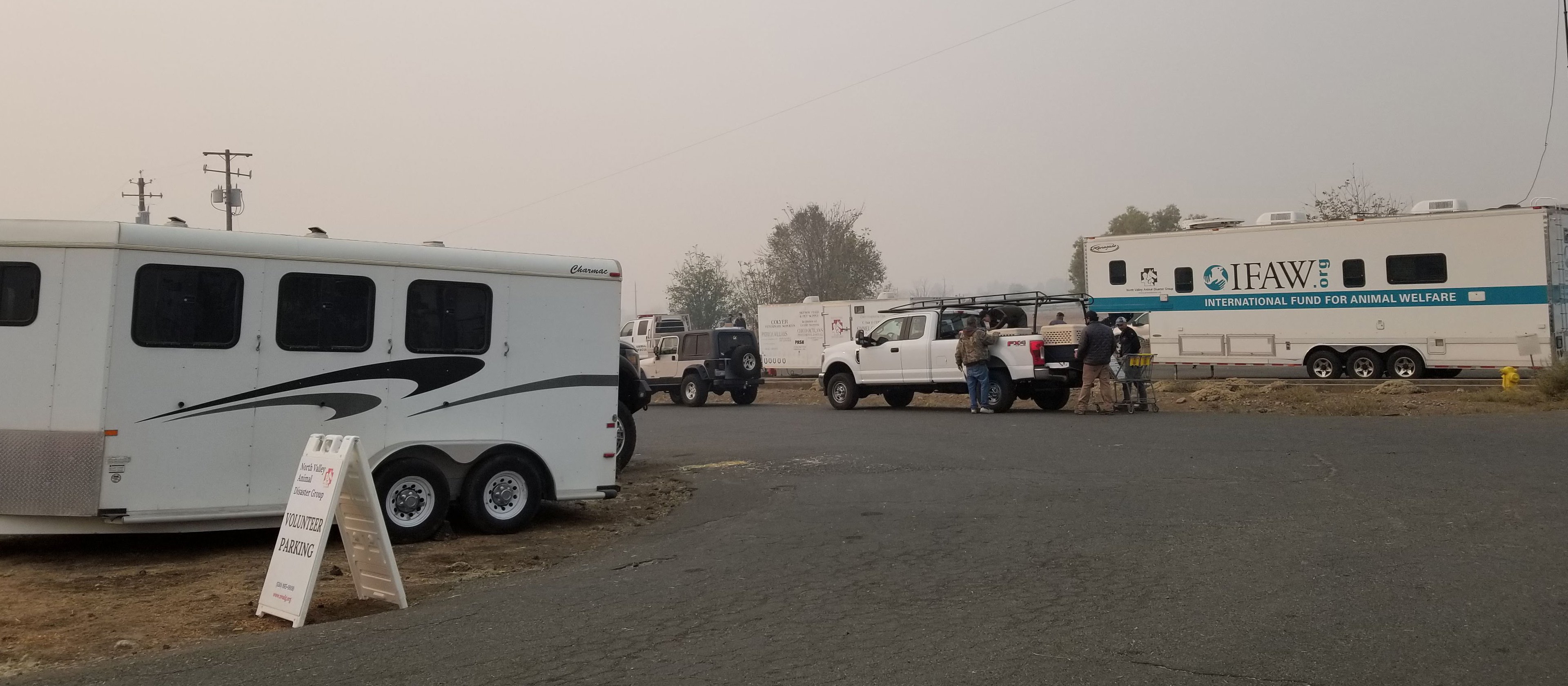
The International Fund for Animal Welfare (IFAW) was asked by someone to come in, and their advisors were a great and calming influence. They helped create order at the larger emergency shelter in Chico, and established routines and schedules that will greatly benefit the animals. There are plans to set up two entirely new locations for the ongoing management of these shelters; all the “owned” animals will be moved to one shelter, and the as-yet unclaimed animals will be moved to the other. A rumor is going around that the Humane Society of the United States (HSUS) will be running one of the shelters, which, if they run it like IFAW, will be supremely welcome.
I took a break from the shelter one day and, instead, allowed myself to be recruited by a friend who was volunteering at NVADG’s warehouse-based headquarters, where a room full of laptops – lent to the group by some office in the county government – had been set up by volunteers.
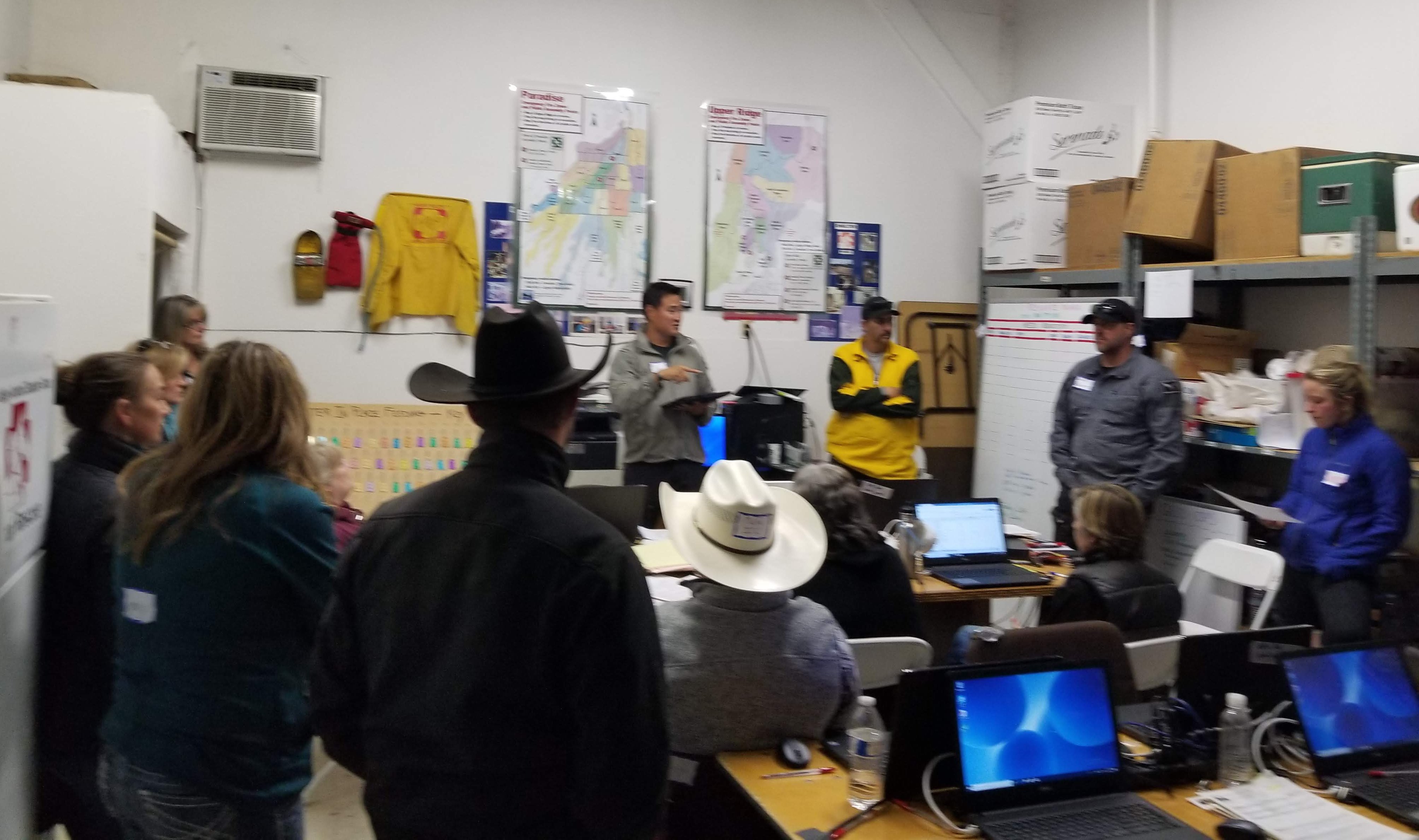
Someone had built a custom file for NVADG so that volunteers could enter data regarding animals and requests for service so the group could, among other things, generate a “feeding report” each day – a list of addresses where the NVADG volunteers would be dispatched to feed livestock (and quite a few cats) who are being “sheltered in place” behind the evacuation lines (but out of danger from the still-burning fire). About 15 of us spent the day (and others spent more days than me) typing in information from forms that had been filled out by the more highly trained and experienced NVADG volunteers who were going into the evacuation zone each day and continuing to rescue some animals and simply feed and water others.
Also at NVADG’s hub of activity: volunteers answering the phones from people with requests for service; volunteers who were helping unload giant truckloads of hay, grain, chicken food, dog and cat food, bowls, beds, blankets etc. that have been donated by people from all over; volunteers loading this donated feed into the trucks of the people who were going out to feed and rescue animals; volunteers who were feeding all the other volunteers! And all this a week into the fire disaster. It was incredibly moving to see this amount of support for the community’s animals, pets and livestock alike.
It’s Thanksgiving, and if there is one thing in all this darkness that I am grateful for, it’s how amazingly generous, kind, and helpful the people in my community are being to each other right now.


